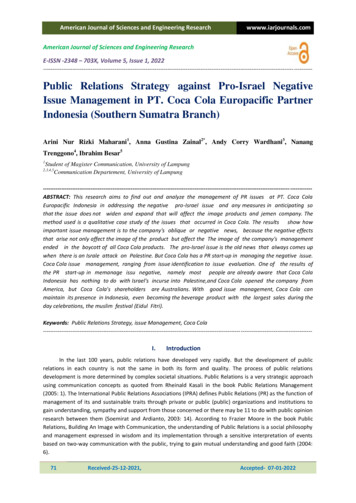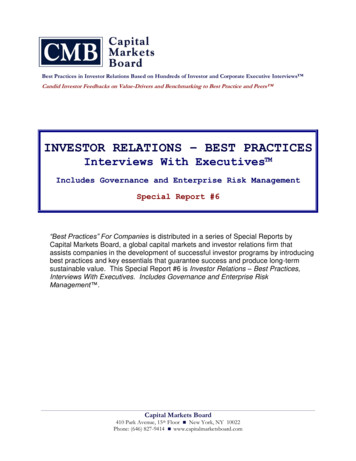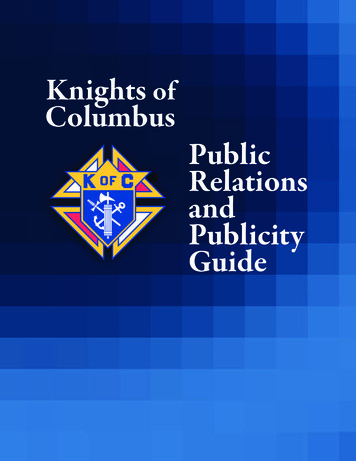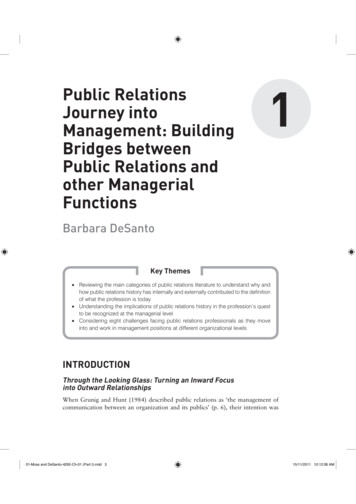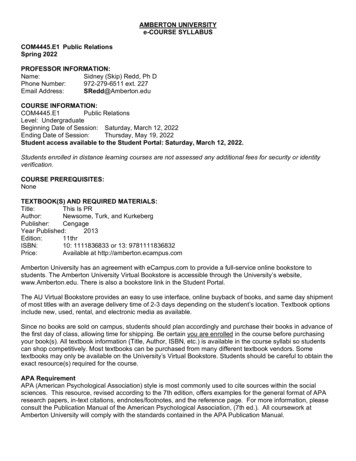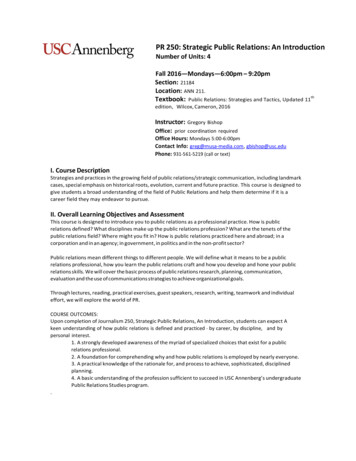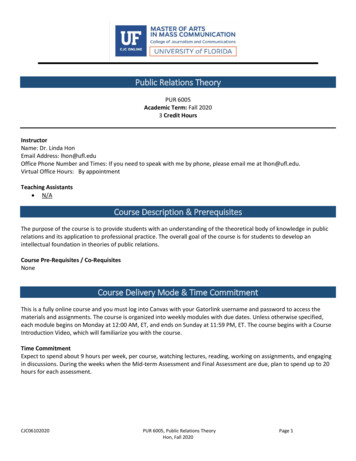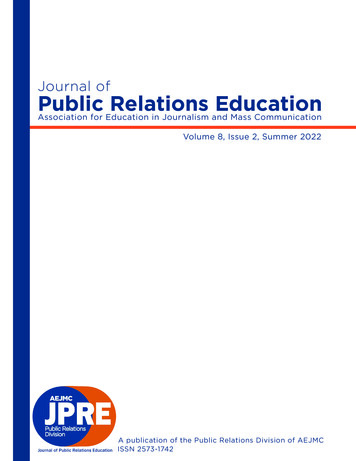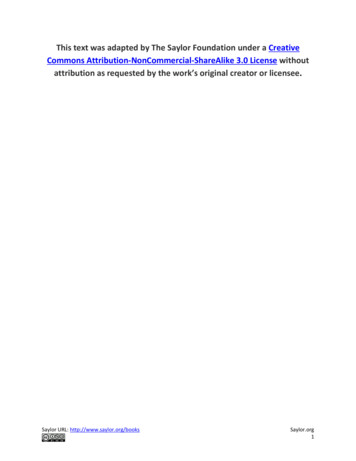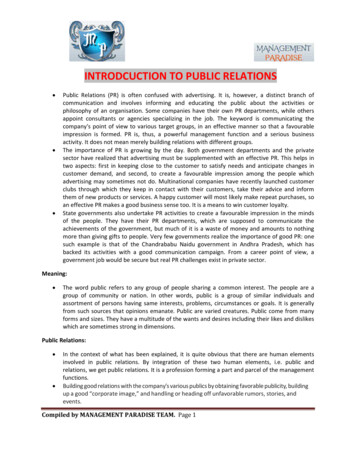
Transcription
INTRODCUCTION TO PUBLIC RELATIONS Public Relations (PR) is often confused with advertising. It is, however, a distinct branch ofcommunication and involves informing and educating the public about the activities orphilosophy of an organisation. Some companies have their own PR departments, while othersappoint consultants or agencies specializing in the job. The keyword is communicating thecompany's point of view to various target groups, in an effective manner so that a favourableimpression is formed. PR is, thus, a powerful management function and a serious businessactivity. It does not mean merely building relations with different groups.The importance of PR is growing by the day. Both government departments and the privatesector have realized that advertising must be supplemented with an effective PR. This helps intwo aspects: first in keeping close to the customer to satisfy needs and anticipate changes incustomer demand, and second, to create a favourable impression among the people whichadvertising may sometimes not do. Multinational companies have recently launched customerclubs through which they keep in contact with their customers, take their advice and informthem of new products or services. A happy customer will most likely make repeat purchases, soan effective PR makes a good business sense too. It is a means to win customer loyalty.State governments also undertake PR activities to create a favourable impression in the mindsof the people. They have their PR departments, which are supposed to communicate theachievements of the government, but much of it is a waste of money and amounts to nothingmore than giving gifts to people. Very few governments realize the importance of good PR: onesuch example is that of the Chandrababu Naidu government in Andhra Pradesh, which hasbacked its activities with a good communication campaign. From a career point of view, agovernment job would be secure but real PR challenges exist in private sector.Meaning: The word public refers to any group of people sharing a common interest. The people are agroup of community or nation. In other words, public is a group of similar individuals andassortment of persons having same interests, problems, circumstances or goals. It is generallyfrom such sources that opinions emanate. Public are varied creatures. Public come from manyforms and sizes. They have a multitude of the wants and desires including their likes and dislikeswhich are sometimes strong in dimensions.Public Relations: In the context of what has been explained, it is quite obvious that there are human elementsinvolved in public relations. By integration of these two human elements, i.e. public andrelations, we get public relations. It is a profession forming a part and parcel of the managementfunctions.Building good relations with the company’s various publics by obtaining favorable publicity, buildingup a good “corporate image,” and handling or heading off unfavorable rumors, stories, andevents.Compiled by MANAGEMENT PARADISE TEAM. Page 1
Not only must the company relate constructively to customers, suppliers, and dealers, but it mustalso relate to a large number of interested publics.A public is any group that has an actual or potential interest in or impact on acompany’s ability to achieve its objectives.Public relations (PR) involves a variety of programs designed to promote or protect acompany’s image or its individual products.Institute of Public Relations – UK (IPR) “Public Relations practice is the planned and sustained effort to establish and maintaingoodwill and mutual understanding between an organization and its publics”.HISTORY It was 1914. In America Rock‐feller family was a big name in business. But they had a badreputation among the common people. So it became very troublesome to run the businesssuccessfully. To come out of this situation Rockefeller (Junior) contacted a person called IVYLedbetter Lee. Primarily Lee was a reporter but later on took public relations as his bread andbutter. The Rockefeller's appointed him as public relations officers. Lee took the job as achallenge. As a first step Lee sent a letter to the press informing the people about the realsituation. Finally the theory clicked and Rockefeller's overcame the crisis. Lee became popular.His theory was "The public be informed", i.e. to inform the people at first hand about thetruth. It worked later; many organisations took help from Lee and succeeded to overcome thecrisis. It is said that Lee was the real father of modern public relations. In USA before Lee there were few pioneers, like Phineas T Barnum and Venderbilt, were there inpublic relations. But they did not succeed. Because, Barnum's Theory was "The public befooled" and Vanderbilt stressed on "The public be damned". Before Second World War PR waspracticed less as a matter of deliberate PR policy but more out of share necessity fordisseminating information. During this stage conscious PR started. The importance of publicrelations was widely accepted and appreciated in the Second World War. This stage stillcontinues but with a further development. In ancient age Greece, Rome and India used publicrelations as a weapon for religion, cultural and expanding kingdom. In Greece the purpose ofholding Olympic games was nothing but simple PR. Preaching's of Lord Buddha, inscriptions ofKing Ashoka — all were the different ways of public relations. In the French revolution Lui theXVI and his Royal family lost power while alienated from the mass. Later they realized theimportance of public relations. Due to social change and technological advancement the needto mobilize public opinion was felt. Emergence of big organisations and their irresponsibilitytowards society gave rise to the need for deliberated PR activity. Emergence of widelycirculated newspapers and influential press was also responsible for the need of modern publicrelations.Compiled by MANAGEMENT PARADISE TEAM. Page 2
It has been proved that PR has a great role in developing favourable equations with each of thevarious publicise with which it is concerned. External as well as internal communications ‐ inboth cases public relations can bring dramatic results. For launching a few products, work ismore than half done if an organisation establishes a reputation beforehand for quality andreliability. Better reputation will score. Also, closest rapport should exist between the topmanagement and the employees through the PR set up of the Organisation. In India development of PR was a much slower process. Here the Tata's started public relationsin 1892. They specially stressed on internal PR like, building Industrial Township for employees,helping employees and their family in the educational and cultural field, etc. But, IndianRailways gave more importance in external public relations.What Public Relations Does Public relations help our complex, pluralistic society to reach decisions and function moreeffectively by contributing to mutual understanding among groups and institutions. It serves tobring private and public policies into harmony. Public relations serves a wide variety ofinstitutions in society such as businesses, trade unions, government agencies, voluntaryassociations, foundations, hospitals, schools, colleges, and religious institutions. To achieve theirgoals, these institutions must develop effective relationships with many different audiences orpublics such as employees, members, customers, local communities, shareholders, and otherinstitutions, and with society at large. The managements of institutions need to understand the attitudes and values of their publics inorder to achieve institutional goals. The goals themselves are shaped by external environment.The public relations practitioner acts as a counselor to management and as a mediator, helpingtranslate private aims into reasonable, publicly acceptable policy and action. As a managementfunction, public relations encompasses the following:¾ Anticipating, analyzing and interpreting public opinion, attitudes, and issues that might impact, forgood or ill, the operations and plans of the organization.¾ Counseling management at all levels in the organization with regard to policy decisions, courses ofaction, and communications, taking into account their public ramifications and the organization'ssocial or citizenship responsibilities.¾ Researching, conducting, and evaluating, on a continuing basis, programs of action andcommunication to achieve the informed public understanding necessary to success of anorganization's aims. These may include marketing, financial, fund raising, employee, community orgovernment relations, and other programs.¾ Planning and implementing the organization's efforts to influence or change public policy.¾ Setting objectives, planning, budgeting, recruiting and training staff, developing facilities ‐‐ in short,managing the resources needed to perform all of the above.¾ Examples of the knowledge that may be required in the professional practice of public relationsinclude communication arts, psychology, social psychology, sociology, political science, economics,and the principles of management and ethics. Technical knowledge and skills are required forCompiled by MANAGEMENT PARADISE TEAM. Page 3
opinion research, public issues analysis, media relations, direct mail, institutional advertising,publications, film/video productions, special events, speeches, and presentations.In helping to define and implement policy, the public relations practitioner uses variety ofprofessional communications skills and plays an integrative role both within the organization andbetween the organization and the external environment. Public is a group of people having commoninterests or characteristics; specific: the group at which a particular activity or enterprise aims.While the term "the public" is often used, there are, in fact, many publics or specific audienceswithin the general public. These publics respond in different ways so they must be consideredseparately and, often, communicated to differently and through differing media. Publics oftenoverlap, and they can be identified and sub‐divided in many different ways.BENEFITS OF PUBLIC RELATIONS1. Prestige or ‘favourable image’ and its benefitsThe familiarialty and reputation of its name are among the greatest assets of any organization – whetherit deals directly with the public or not. Everyone is influenced by Reputation because reputation inindustry can rarely be one without true accomplishments.2. Promotion of products and servicesTelling people about products and interesting them, in purchasing requires more than advertisingefforts. People’s tastes and desires are developed by the unobtrusive influences by them. Theseunobtrusive, non‐selling influences have an immeasurable effect on their desire to buy.3. Determining the organization’s posture in dealing with its publicsIncreasing sophistication had modified how organizations have approached their relations with variousgroups. There are 3 major conceptions of that role:1) To master the publics; to direct what they think and do, according to the desires of theorganization involved2) To block; to react to developments and problems, to respond to events or the initiatives ofothers by blunting them3) To achieve mutual adaptation; to develop relations of mutual benefits all parties involvedIn the present human climate, achieving mutual adaptation, has become the most widely taken course.4. Fostering the GoodwillGoodwill of:Compiled by MANAGEMENT PARADISE TEAM. Page 4
-The employeesCommunities in which the organization has unitsStockholdersSuppliersGovernmentRest of the industryDealersCustomersSupporters5. Helps in building BrandsBuilding Brands becomes easy when proper public relations exist. Brand vitality and brand credibilityfollow. This can be concluded from a national poll of brand managers. The brand managers have givenauthentication that public relation is the most effectual way to institute brand credibility. Maximumutility can be derived on every marketing rupee spend. More than half the voters i.e., brand managersregard that, PR are more imperatively judged against advertising, sales promotion and new media. PRpaves the path for effective communications discipline though the editorial context cannot be put aside.PR is the best way to gather third party endorsements according to brand managers. The survey clearlystates that PR is a valued marketing partner in building brand equity. Probably the return earned on themarketing rupee spent makes the brand managers, give more importance to public relations.6. Prevention and Solution of Labour ProblemsPublic Relations can assist in stabilizing labor conditions through employee relations activities. The useof public relations as a labour stabilizing aid is preventive as well as curative and it’s most beneficialwhen it is carried on continuously rather than only when strike clouds appear.7. Overcoming Misconceptions and PrejudicesPrejudices that may exist because misinformation has been spread also threaten the success ofbusiness. Analysis of the situation, plans for meeting it, and the dissemination of correct information canclear up these difficulties8. Ability to attract the Best PersonnelNo organization’s future is any better than the caliber of future executives it is able to attract. Making acompany or organization known and respected is necessary to assure its healthful development.9. Education of the Public to the use of a productWhen an entirely new service or product is to be promoted, it is necessary to capture the imagination ofthe public in order to make the item attain steady sales. When a company brings out a new type ofCompiled by MANAGEMENT PARADISE TEAM. Page 5
product, public relations must support advertising and the sales staff in capturing the public’simagination.10. Education of the Public to appoint a viewWhen an organization seeks to win support for its method of operation, its principles, the system thatsupports it, or any other viewpoint, its most effective means are the channels of teaching the public thatare constant being utilized by Public relations people11. Dealing with EmergenciesThis has three phases:1) Monitoring whatever may cause unexpected difficulties for the organization2) Preparing for meeting the full range of such emergencies3) Actual handling of matters when there is an emergency12. Directing the course of changeAt its best, public relations is a bridge to change. It is a means to adjust to new attitudes that have beencaused by change. It is a means of stimulating attitudes in order to create change. It provides judgmentcreativity and skills in accommodating changing groups to each other.13. Altering Misconceptions:In India some PR agencies and independent consultants are doing just that. An example of anadvertising management would be when pictures of Pepsi bottles with fungus in them were splashed innewspaper, their agency, Perfect Relations launched an intensive media awareness campaign with themisinformation in the media. How did they do this? They highlighted that 40 percent of Pepsi bottled inIndia was spurious, established that the bottle reproduced in newspapers was not an original one, andthen suggested Government needed to take a firm stand on enforcing laws against spuriousmanufacturers of consumables.What happened in the end was that many illicit plants were raided andclosed down, Pepsi emerged as the aggrieved party and the case was diminished.14. Issues and Perception Management:The Issues Management departments of companies or of consultancies today have become a part of atotal system of anticipative Public Relations. A fair amount of research has to be done by thecommunications department to be able to track issues that could affect companies in the long run.PUBLIC RELATIONS HAVE BOTH ADVANTAGES AND DISADVANTAGES.Advantages include:Compiled by MANAGEMENT PARADISE TEAM. Page 6
1. Credibility: Because PR communications are not perceived in the same light as advertising – thatis, the public does not realize the organization either directly or indirectly paid for them – they tend tohave more credibility. The fact that the media are not being compensated for providing the informationmay lead receivers to consider the news more truthful and credible. For example, an article innewspapers or magazines discussing the virtues of aspirin may be perceived very much as more crediblethan an ad for a particular brand of aspirin.2. Cost: In both absolute and relative terms, the cost of PR is very low, especially when the possibleeffects are considered. While a firm can employ PR agencies and spend millions of dollars on PR, forsmaller companies, this form of communication may be the most affordable alternative available.3. Avoidance of Clutter: Because they are typically perceived, as news items, PR messages are notsubject to the clutter of ads. A story regarding a new product, introduction of break through is treatedas a news item and is likely to receive attention.4. Lead Generation: Information about the technological innovations, medical break‐throughs andthe like results almost immediately in a multitude of inquiries. These inquiries may give the firm somequality sales lead.5. Ability to reach specific groups: Because some products appeal to only small market segments, it isnot feasible to engage in advertising and / or promotions to reach them. If the firm does not have thefinancial capabilities, to engage in promotional expenditures, the best way to communicate to thesegroups is through PR.6. Image Building: Effective PR helps to develop positive image for the organization. A strong imageis insurance against later mis‐fortunes.Perhaps, the major disadvantage of PR is the potential for not completing communication process.While PR messages can break through the clutter of commercials, the receiver may not make theconnection to the source. Many firms’ PR efforts are never associated with their sponsors in the publicmind.PR may also mis‐fire through mis management and a lack of co‐ordination with the marketingdepartment. When the marketing and PR department operate independently, there is a danger ofinconsistence communication, redundancies in efforts and so on.The key to effective PR is to establish a good program, worthy of public interest and manage it properly.To determine if this program is working, the firm must measure the effectiveness of the PR effort.Compiled by MANAGEMENT PARADISE TEAM. Page 7
ELEMENTS OF PUBLIC RELATIONSCounseling ‐‐ Providing advice to the management of an organization concerning policies, relationshipsand communications; in effect, "what to do."Research ‐‐ Determining attitudes and behaviors of publics and their causes in order to plan, implementand measure activities to influence or change the attitudes and behavior.Media Relations ‐‐ Relating with communications media in seeking publicity or responding to theirinterest in an organization.Publicity ‐‐ Disseminating planned messages through selected media without payment to further anorganization's interest.Employee/Member Relations ‐‐ Responding to concerns and informing and motivating an organization'semployees or members, its retirees and their families.Community Relations ‐‐ Continuing, planned and active participation with and within a community tomaintain and enhance its environment to the benefit of both an organization and the community.Public Affairs ‐‐ Developing effective involvement in public policy, and helping an organization adapt topublic expectations; also, term used by military services and some government agencies to describetheir public relations activities.Government Affairs ‐‐ Relating directly with legislatures and regulatory agencies on behalf of anorganization, usually by military services and some government agencies to describe their publicrelations activities.Issues Management ‐‐ Identifying and addressing issues of public concern in which an organization is, orshould be, concerned.Financial Relations ‐‐ Creating and maintaining investor confidence and building positive relationshipswith the financial community; also, sometimes known as Investor Relations or Shareholder Relations.Industry Relations ‐‐ Relating with other firms in the industry of an organization and with tradeassociations.Development/Fund Raising ‐‐ Demonstrating the need for and encouraging an organization's members,friends, supporters and others to voluntarily contribute to support it.Minority Relations/Multicultural Affairs ‐‐ Relating with individuals and groups in minorities.Special Events and Public Participation ‐‐ Stimulating an interest in a person, product or organization bymeans of a focused "happening;" also, activities designed to enable an organization to listen to andinteract with publics.Compiled by MANAGEMENT PARADISE TEAM. Page 8
Marketing Communications ‐‐ Combination of activities designed to sell a product, service or idea,including advertising, collateral materials, publicity, promotion, packaging, point‐of‐sale display, tradeshows and special events.SERVICES OF PR PRACTITIONERS AND CONSULTANTS Market, consumer, client and employee market research.Analyzing issues and policies affecting internal and external stakeholders.Identifying vulnerabilities that may threaten an organization's reputation both publicly andinternally.Managing crisis communications and media relations.Recommending ways to build positive reputations.Developing and implementing communications strategies and tactics to take advantage ofopportunities or solve problems.Developing training programs to facilitate the flow of corporate information.Evaluating communications programs and suggesting ways to improve future effectiveness.Anticipating and planning for the prevention of public relations problems.How Public Relations Helps Management1. The publicity and promotional aspect paves the way for the sale of products or services, so much sothat some companies have placed sales quotas on their product publicity people.2. Internal motivation is a vital factor, which affects the bottom line by building morale, enhancingproductivity and creating team spirit. It also helps recruit qualified people and retain them.3. Public relations provide an early warning system by avoiding disruptions, which may occur when asingle surprise issue or unplanned‐for social/political change arises.4. Public relations provide an organization with new opportunities because the people involved inpublic relations interact with more internal and external audiences than anyone else in theorganization. Public relations people have a conning tower from which to identify new markets, newproducts, and new methods.5. Public relations help to protect the present position when an organization is under attack. Forinstance, Proctor and Gamble did not suffer declining sales, morale or stock values during thetampon debacle largely because of their expert public relations handling of the problem ‐‐communicating the company's position.6. Public relations help to overcome executive isolation, something that can affect every organizationsooner or later. An inescapable assignment of every public relations practitioner is opening the eyesand ears of management to what's really happening "out there."Compiled by MANAGEMENT PARADISE TEAM. Page 9
7. Public relations help organizations manage change, something they must do to stay competitive andefficient. But since change is threatening and often resisted, smooth transition through a necessarychange guided by public relations professionals is a real dollar‐saver.8. The phrase "double bottom line" was coined to explain the relationship between an organizationand its social responsibility. It's now well understood and accepted that social responsibility doeshave a traceable effect on economic success for every type organization. Public relations staffusually plays the leading role in “social accountancy”.How Public Relations Benefits Society Public relations are a means for the public to have its desires and interests felt by institutions inour society. It speaks for the public to otherwise unresponsive organizations, as well as speakingfor those organizations to the public. Public relations help achieve mutual adjustment between institutions and groups, establishingsmoother relationships that benefit the public. Public relations can be a safety valve for freedom. By providing means of working outaccommodations, it makes arbitrary action or coercion less likely. Public relations are an essential element in the communications system that enables individualsto be informed on many aspects of subjects that affect their lives. Public relations can help activate organization's social conscience. Public relations is a universal activity. Everyone practices principles of public relations in seekingacceptance, cooperation or affection of others. Public relations professionals only practice it in a more professional way.PUBLIC RELATIONS PRACTICESCommunity RelationsPublic relations practitioners for a broad range of corporate and not‐for‐profit organizations carry outCommunity relations. Its primary objective is to establish and maintain mutually satisfactoryrelationships with community and special interest groups in the locations where an organization hasoperations. Community relations work is distinguishable from public relations and public affairs workmainly in that it deals with a specific local.Crisis CommunicationsCrisis Communications is practiced when an organization becomes involved in an emergency situationaffecting one or more if its stakeholders. During a crisis situation, various methods and policies are usedto distribute accurate, complete information. These situations constitute major crises because thereputation of a company, industry, product or services is in jeopardy.Employee CommunicationsEmployee Communications means clear, honest and timely communications with employees aboutissues that are important to their working lives. Such issues may include additions or reductions in staff,changes to working conditions, procedure, policy or benefits. Employees of an organization are asCompiled by MANAGEMENT PARADISE TEAM. Page 10
informed as external stakeholders, and are enabled to function as the organization's informal publicrepresentatives, with a commitment to its mission and pride in its products or services.Fund Raising"Fund‐raising has become an vital element in the operations of virtually all not‐for‐profit organizations.Public relations practitioners participate directly in a variety of ways, from organizing and conductingsolicitation programs and special events, to serving as consultants to specialized developmentdepartments of their organizations."Government RelationsGovernment relations involve communication with relevant members of the public service or withpolitical officials in order to influence government policy and/or regulations that would favourablyposition the organization's products, services or reputation. Organizations that most often requiregovernment relations’ practitioners are those that have government‐regulated products or services (e.g.electricity, social services), or those that provide products or services to or on behalf of government (i.e.public‐private partnerships).Investor RelationsThe objective of investor relations is to build the relationship between listed companies and investors byensuring a flow of corporate information to individuals who own stock or have an interest in thecorporation. The corporate function of investor relations is also called stockholder communications."(Financial relations is). . A parallel function of investor relations is to provide extensive information tothe financial community"Marketing CommunicationsMarketing communications incorporates public relations functions (e.g. newsletters, media relations,public speaking) with marketing initiatives (e.g. advertising, product promotion). The line between thesetwo functions has become increasingly blurred as organizations have come to value traditional publicrelations tactics as integral components in overall reputation management and sales strategies.MeasurementMeasurement gages the effectiveness of a PR program, event or strategy using formal or informalresearch. A sound communications plan requires an evaluation stage whereby final results are measuredagainst goals and objectives. The type of techniques used will vary depending on the complexity of theproject undertaken. Most importantly, these techniques must show how successfully the informationwas communicated to the target audience(s).ROLE OF PUBLIC RELATIONS PR professionals can do anything from coordinating a company sponsored golf tournament togiving newspaper reporters a tour of a new factory. PR reaches its wide range of audiences byusing any number of PR techniques to convey its messages.Whether it be through a private PR agency or an in house PR department, the PR person isCompiled by MANAGEMENT PARADISE TEAM. Page 11
required to undertake major functions. Following are some of the important PR functionsand activities:1. COMMUNICATING WITH PR ‘PUBLICS’We are all a ‘public’ of one kind or another, whether we are consumers of products,employees, shareholders, or members and customers of a company, organization, trade orprofessionals association. ‘Publics’ in the PR language are classified into internal and external publics.Internal Communication: Full and part time employees of an organization, their families, trainees,trade union officials, form the internal publics of an organization. Employee communication is a vitalpart of any PR programme. The ultimate success of the organization depends largely on the success ofits internal communication. This ensures smooth flow of information from the management t
Public relations (PR) involves a variety of programs designed to promote or protect a company's image or its individual products. Institute of Public Relations - UK (IPR) "Public Relations practice is the planned and sustained effort to establish and maintain
